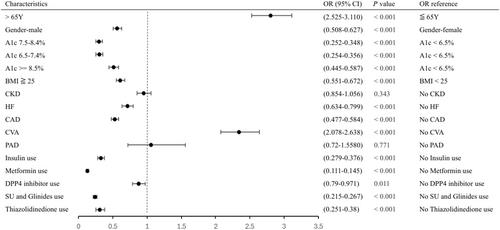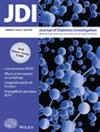Suboptimal physician adherence to evidence-based guidelines for managing cardiorenal comorbidities in diabetes care: A retrospective single-center study in Taiwan
Abstract
Aims
In patients with diabetes and cardiorenal comorbidities, sodium–glucose cotransporter 2 inhibitors (SGLT2is) and glucagon-like peptide 1 receptor agonists (GLP-1 RAs) are critical to secondary outcome prevention. This study investigated physicians' adherence to current cardiorenal-diabetic prescription guidelines for such patients.
Materials and Methods
This observational, retrospective-cohort, single-center study enrolled 7,805 adults (mean age 71 years; mean HbA1c level 7.4%) with type 2 diabetes mellitus and atherosclerotic cardiovascular disease (ASCVD), heart failure (HF), or chronic kidney disease (CKD). Patients' demographic information, comorbidities, medication history, and laboratory data were collected. Physician adherence was defined as a patient with ASCVD receiving an SGLT2i or GLP-1 RA and a patient with CKD or HF receiving an SGLT2i. The baseline characteristics of the adherence and nonadherence groups were compared.
Results
Only 28.4% of prescriptions adhered to guidelines. Patients in the physician-adherent group had higher HbA1c levels, body mass index, and age, and more comorbidities. Logistic regression revealed that older age [odds ratio (OR) 2.29, 95% confidence interval (CI) 2.014–2.604, P < 0.001], cerebrovascular accident history (OR 1.591, 95% CI 1.357–1.865, P < 0.001), and dipeptidyl peptidase 4 inhibitor use (OR 2.359, 95% CI 2.062–2.700, P < 0.001) were associated with physician nonadherence.
Conclusions
Only a suboptimal percentage of patients with diabetes and cardiorenal disease in Taiwan receive SGLT2is and GLP-1 RAs despite these medications' recognized cardiorenal benefits. Further action is required to improve physician adherence in patients with greater age, cerebrovascular accident history, and dipeptidyl peptidase 4 inhibitor use.


 求助内容:
求助内容: 应助结果提醒方式:
应助结果提醒方式:


